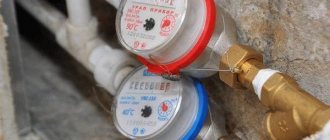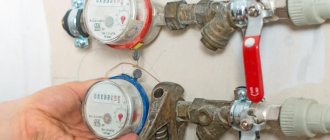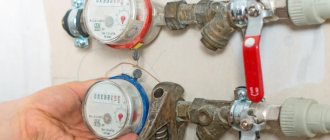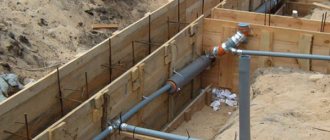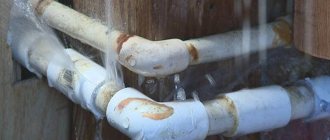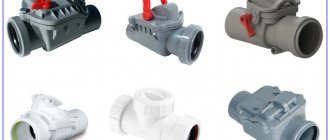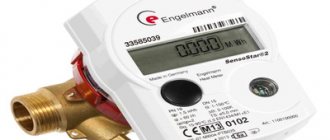Federal legislation obliges property owners to use meters for water, gas, electricity and heat. This is stated in the fifth and sixth articles of 261-FZ of 2009. And if there is a meter in the apartment, transmitting the readings becomes the responsibility of the homeowner. According to generally accepted rules, information about water consumption must be transmitted from the 15th of the current month to the 3rd of the next month. This can be done manually using supplier-approved information channels, or automatically by purchasing a smart meter.
The most convenient ways to transmit water meter readings
Moscow residents can use the following communication channels:
- City Hall portal mos.ru - a form for transmitting testimony is available in your personal account;
- “Moscow State Services” application - it can be installed on an iOS or Android device;
- the “My Moscow” application, or more precisely, its “My Home” section;
- multi-channel call center line, this number is open 24 hours a day;
- automatic service for receiving SMS messages - 7377;
- drop boxes for information in managers' offices.
For residents of the Moscow region, the most convenient communication channel is the unified information and settlement center - MosOblEIRTS. As an alternative method, you can use payment terminals and “Personal Accounts” on the websites of your management companies.
Installing a water meter on site: features of cost accounting
Question from Clerk.Ru reader Tatyana (Podolsk)
Installation of a water metering station for wastewater metering (water meter) - is this the cost of modernization (sewage) or the ongoing costs of operating the facility? Is it possible to capitalize an object as a separate OS? If not, how can this be reflected in accounting?
As is known, expenses for current and major repairs are taken into account at a time (clause 27 of PBU 6/01 “Accounting for fixed assets”, approved by Order of the Ministry of Finance of Russia dated March 30, 2001 N 26n; Article 260 of the Tax Code of the Russian Federation), and costs for modernization and reconstruction increase the cost of the fixed asset (clause 27 of PBU 6/01; clause 2 of Article 257 of the Tax Code of the Russian Federation) and will be recognized as expenses only through depreciation. Therefore, to correctly account for the cost of work and to avoid undesirable tax consequences, it is important to determine whether they relate to repairs or modernization.
It is sometimes difficult even for a technical specialist to distinguish between repair and reconstruction, especially when it comes to real estate.
For reference.
In accordance with the All-Russian Classifier of Fixed Assets OK 013-94, approved. By Decree of the State Standard of Russia dated December 26, 1994 N 359, sewerage with all devices is included in the building, as are its internal communications.
To determine the main criteria by which one can determine whether it is a repair or a modernization, it is most logical to refer to the wording given in the Tax Code.
In accordance with paragraph 2 of Art. 257 of the Tax Code of the Russian Federation, completion, retrofitting and modernization include work caused by a change in the technological or service purpose of equipment, a building, structure or other object of depreciable fixed assets, increased loads or other new qualities.
If we talk about repair, then it is the maintenance or restoration of the original qualities of an object by, for example, replacing a broken part. However, as such, the concept of repair is absent in the Tax Code.
Therefore, to qualify certain works, it is better to use special documents, such as: - Regulations on carrying out scheduled preventive maintenance of industrial buildings and structures MDS 13-14.2000, approved. Decree of the USSR State Construction Committee dated December 29, 1973 N 279; — Regulations on the organization and implementation of reconstruction, repair and maintenance of buildings, communal and social-cultural facilities (VSN) N 58-88 (R), approved. By order of the State Committee for Architecture under the USSR State Construction Committee dated November 23, 1988 N 312; — Letter of the USSR Ministry of Finance dated May 29, 1984 N 80 “On the definition of the concepts of new construction, expansion, reconstruction and technical re-equipment of existing enterprises.”
These documents describe in sufficient detail which works relate to current and major repairs, and which to reconstruction or modernization.
From these documents it also follows that the purpose of the work and the consequences for the fixed asset will be of decisive importance for the qualification of the work carried out (repair or modernization). Thus, the purpose of modernization and reconstruction is to improve (increase) the initially adopted standard indicators of the functioning of a fixed asset object.
The purpose of repair is to eliminate faults (replacement of worn-out (broken) parts (structures)), the presence of which makes the operation of the fixed asset impossible or dangerous.
Taking into account the ambiguity of the decision to qualify the work (repair or modernization), the Ministry of Finance of Russia in Letter dated November 23, 2006 N 03-03-04/1/794 also recommended being guided by the above documents:
In addition, when resolving controversial issues, the courts are guided by the same documents (Resolutions of the Federal Antimonopoly Service of the Moscow Region dated December 16, 2009 N KA-A40/13427-09, dated October 24, 2008 N KA-A40/9881-08; Federal Antimonopoly Service of the North-Western Territory dated December 4, 2009 in the case N A05-3564/2009; FAS PO dated January 18, 2005 in case N A57-11449/03-7).
Taking into account the above and the content of the question, we can conclude that the organization, having installed a water metering unit, modernized the sewer system as an integral part of the building.
Therefore, it is recommended to carry out accounting of modernization costs taking into account the standards of the Accounting Regulations “Accounting for Construction Contracts” PBU 2/2008, approved. By Order of the Ministry of Finance of Russia dated October 24, 2008 N 116n, Regulations on accounting of long-term investments, approved. Letter of the Ministry of Finance of Russia dated December 30, 1993 N 160, and the Accounting Regulations “Accounting for Fixed Assets” PBU 6/01, approved. By Order of the Ministry of Finance of Russia dated March 30, 2001 N 26n.
In accounting, an increase in the initial cost of fixed assets at which they are accepted for accounting is allowed, in particular, in the case of modernization (technical re-equipment), as a result of which the initially accepted standard indicators of the functioning of a fixed asset object are improved (increased).
In the case under consideration, based on the above, the costs of modernization will be reflected in the accounting records as the debit of account 08 “Investments in non-current assets”, subaccount 08-3 “Construction of fixed assets”, in correspondence with the credit of account 60 in a separate subaccount, for example in subaccount 60 -1 “Settlements with contractors for work performed” (Instructions for using the Chart of Accounts).
The amount of VAT presented by contractors is reflected in the debit of account 19 “Value added tax on acquired assets” in correspondence with the credit of account 60, subaccount 60-1 (Instructions for using the Chart of Accounts).
After completion of the modernization work, the costs recorded on account 08, subaccount 08-3 are written off to the debit of account 01 “Fixed assets” (clause 14, 27 PBU 6/01, clause 42 of the Guidelines for accounting of fixed assets, approved by Order of the Ministry of Finance of Russia dated October 13, 2003 N 91n, Instructions for the use of the Chart of Accounts) to increase the initial cost of the corresponding fixed asset.
For reference
Paragraph 6 of PBU 6/01 does not offer the choice of an organization, but directly establishes the need to account for parts of one object as separate inventory items if the useful life of such parts differs significantly from the useful life of the object itself.
According to the List contained in the Introduction to OKOF, approved. By Decree of the State Standard of Russia dated December 26, 1994 N 359, at the discretion of the organization, it is possible to register the following inventory items within the building: the building itself, the heating system, water supply, gas pipeline, sewerage with all devices, power and lighting wiring network, telephone network, alarm network , ventilation, lifts, elevators.
For tax accounting purposes, as well as for accounting purposes, modernization costs are attributed to the increase in the initial cost of the fixed asset (clause 2 of Article 257 of the Tax Code of the Russian Federation).
For reference
In ch. 25 of the Tax Code of the Russian Federation there is no concept of “inventory object”, and in paragraph 1 of Art. 257 of the Tax Code of the Russian Federation there is the concept of “part of the property”, and therefore if part of the building and the building itself have different useful lives, then, in our opinion, they can be considered different objects of fixed assets.
It’s very easy to get personal advice on any tax online - you just need to fill out a special form . Every day two or three of the most interesting questions will be selected, the answers to which you can read in Tatyana Potapova’s consultations.
Instructions for users of the "State Services Moscow" application
- Download the application to your phone, open it, click on “Register”. Enter your phone number and the code from the SMS that the service will send.
- Go through authorization by indicating the house address and apartment number, as well as the 10-digit code indicated in the upper right corner of the single receipt (UR).
- Find the “.
- Select the type of meter - you need a hot or cold water meter.
- In the form that opens, enter the numbers from the meter display and click on the “Submit” button.
What benefits might there be?
There are categories of citizens (families) who enjoy legal installation benefits. Payment of technical conditions and other fees may be reduced or completely waived (compensated), depending on the situation of the family and regional laws.
These categories include:
• families and individuals with the status of “poor”;
• WWII participants;
• subscribers with group I or II disabilities;
• families whose dependent child is disabled.
This is a general list that can be revised at the regional level. To clarify the possibility of installation on preferential terms, you must contact the social support department and water utility in your region for advice.
Instructions for the “My Moscow” application
- Download the application to your phone and go through the registration procedure. To do this, click on the key icon in the upper right corner. In the form that opens, enter your phone number and password (it must consist of five or more characters). To confirm registration, enter the one-time code sent by SMS (sender DIT_EMP).
- Go through the authorization procedure. You need to enter your phone number and password used during registration.
- Go to the “My Home” section, activate a dialogue with the bot and select the “Water Meters” menu.
- In the form that opens, you must indicate the 10-digit code from the UDP (single receipt), house address and apartment number.
- Next, you need to find the counter menu, click on the “Submit” button, enter the numbers from the device display (only whole cubes) and click on “Submit”.
Sending SMS with water consumption readings
- Register in the system by sending the following content to number 7373: water kp “10 digits of the unique EDP code” apartment “your apartment number”. Words in bold are required. Italics should be replaced by unique numbers.
- Submit your readings by sending the following SMS to 7377: water add “cold meter readings” “hot meter readings”.
- Activate the reminder mode about the timing of data transfer by sending an SMS to 7377: water remind.
IMPORTANT: Any channel for transmitting water consumption data only works between the 15th of the current month and the 3rd of the next month (for example, from July 15 to August 3). If you use the site or application during non-working hours, the readings will be postponed to the next month.
Why may they refuse to register a water meter?
There may be a number of reasons why the meter acceptance procedure may be refused. The most common reason for refusal is non-compliance with technical conditions.
It will also not be possible to seal and register if:
• the model is not on the State Register list;
• those passports were not stamped and/or stamped with the date of sale and/or factory inspection;
• there is arrears in payment for services (there is no such law, but in fact, there are suppliers who may refuse to carry out sealing due to debt);
• the verification period has expired (a legislative basis that can be corrected by applying for verification).
Automation of information transfer on water consumption
If you do not submit readings within 3 months, the receipt will be automatically calculated based on the average annual water consumption. In this case, the user is deprived of the right to transfer data in a simplified mode. Further communication with the management company is carried out using the “My Documents” section of the State Services portal. If the consumer does not provide readings within 6 months, the management company sends inspectors to the place of residence, who are required to draw up a meter control report.
Our company offers smart meters that transmit readings to the management company automatically. We have been producing automated devices since 2021 using SAURES control units. They are approved by management companies of Moscow and the Moscow region. Water meter readings are sent to both the management company’s server and the customer’s smartphone. Installing such a metering device will save you from wasting time, money and nerves.
3.5. Drawing up a certificate of registration of a water meter
The act of registration or commissioning is an integral part of the previously drawn up agreement between the service provider and the subscriber.
This document states:
• date, month, year of commissioning;
• service provider, in this case, the organization supplying water;
• details of the specialist who carried out the installation and/or inspection and who drew up this report;
• consumer (owner) data;
• installation address;
• identification number, marking, model;
• indications;
• license plate seal;
• if the meter was previously installed, it is necessary to indicate the data of the last verification, including its date.
The act is drawn up in two copies. This document must be kept for the entire period of use of the meter.
